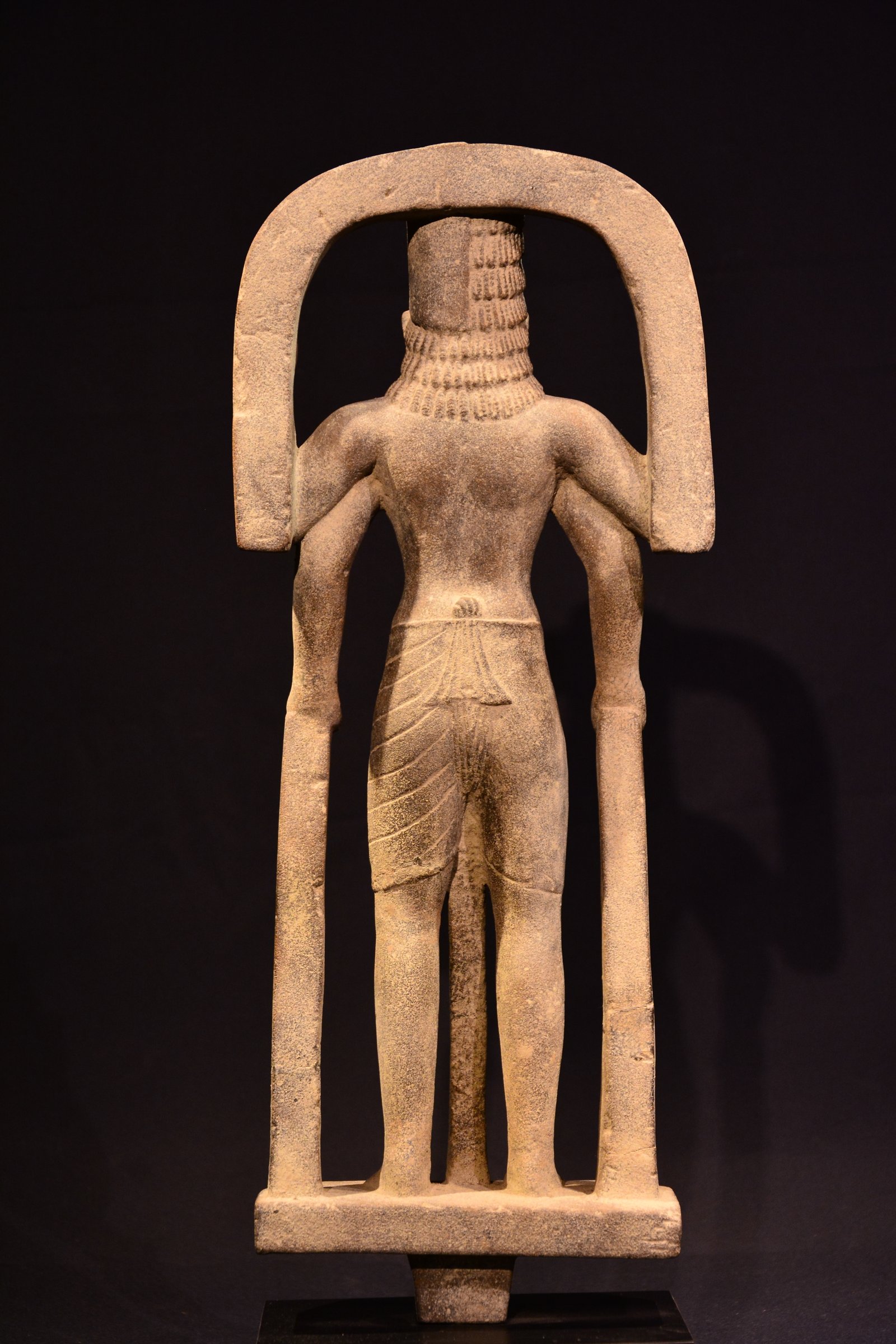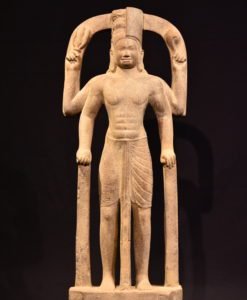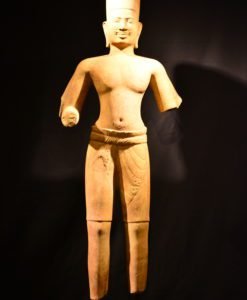12th Century | Panhomda Period | Cambodia | Sandstone
This magnificent sandstone Harihara statue, an exceptional artifact from Cambodia’s Panhomda period, encapsulates the profound artistry and spiritual depth of the Khmer Empire. As a fusion of two great Hindu deities—Shiva and Vishnu—this rare and meticulously crafted sculpture bridges the realms of creation, preservation, and destruction, representing the spiritual and artistic zenith of its era.
Item Description
A Marvel of Khmer Spiritual Synthesis
Emerging from the celebrated Panhomda period, this statue exemplifies the Khmer Empire’s masterful ability to harmonize Hindu iconography with local aesthetic sensibilities. The dualistic symbolism of Harihara—combining Shiva’s transformative energy and Vishnu’s protective grace—reflects the Khmer cultural ethos of balance and unity.
Despite the passage of centuries, the statue retains remarkable integrity, with subtle signs of aging and minor marks from its excavation only enhancing its historical authenticity. Crafted from sandstone, a favored material in Khmer art for its resilience and elegance, this piece has survived as an enduring testament to the empire’s unparalleled craftsmanship.
Intricate Symbolism in Divine Detail
The statue’s iconographic elements are a study in meticulous detail, imbued with symbolic meaning:
- Lower Right Hand: Clutching a spherical object, potentially a sacred fruit symbolizing sustenance and abundance.
- Lower Left Hand: Holding a downward-facing staff, a signature of Shiva, signifying stability and divine authority.
- Upper Right Hand: Brandishing a small trident, a potent emblem of Shiva’s power to destroy ignorance and sustain cosmic balance.
- Upper Left Hand: Bearing a conch shell, an iconic attribute of Vishnu, representing the primordial sound and the cosmic essence.
The bare torso, a hallmark of Khmer sculptural tradition, highlights divine strength and serenity, while the lower garment is simple yet elegant, contrasting the intricate detailing of the deity’s headpiece, which reflects the distinctive styling of Harihara.
Preservation and Patina: Marks of Authenticity
This artifact bears the marks of its journey through time—scratches from excavation tools and a natural patina developed over centuries, testifying to its genuine antiquity. Such aged beauty, combined with its rarity, makes it a prized collector’s piece for those with a discerning eye for Khmer heritage.
Historical and Cultural Significance
Harihara statues from the Panhomda period are celebrated for their dualistic representation of two Hindu deities, a concept deeply ingrained in Khmer religious thought. These statues were often enshrined in sacred temples, serving as focal points of devotion and embodying divine protection.
While the precise origins of this statue remain uncertain, such artifacts were typically unearthed in temple ruins or royal sanctuaries, where they symbolized both spiritual guidance and the Khmer Empire’s artistic grandeur.
A Collector’s Trophy of Unparalleled Prestige
This rare Harihara sandstone statue is a crowning achievement for any collector of Southeast Asian antiquities. Its exceptional artistry, historical resonance, and spiritual depth transcend its status as a mere artifact—it is a timeless emblem of cultural and artistic sophistication.
Acquiring this piece is not only a tangible connection to Cambodia’s storied past but also a statement of refined taste and cultural appreciation. Its presence transforms any space into a gallery of history, spirituality, and elegance.
A Legacy Worth Preserving
Owning this divine masterpiece means becoming the steward of a legacy—a bridge between past and present that honors the artistic and spiritual ingenuity of the Khmer Empire. With its timeless allure and profound narrative, this Harihara statue invites its next custodian to cherish and celebrate its enduring legacy.
References
- Jacques, C., & Freeman, M. (2007). Ancient Angkor. Bangkok: River Books.
- Coedès, G. (1968). The Indianized States of Southeast Asia. Honolulu: University of Hawaii Press.
- Jessup, H. I. (2004). Art and Architecture of Cambodia. London: Thames & Hudson.
#KhmerAntiques #HariharaStatue #PanhomdaPeriod #SoutheastAsianArt #LuxuryCollectibles
PRODUCT DETAIL
Medium: Sandstone
Dimensions:
Height 48 cm
Length – cm
Wide 20 cm
Condition Report: –
Please keep in touch for Price and more information: Mallika1013@gmail.com


























